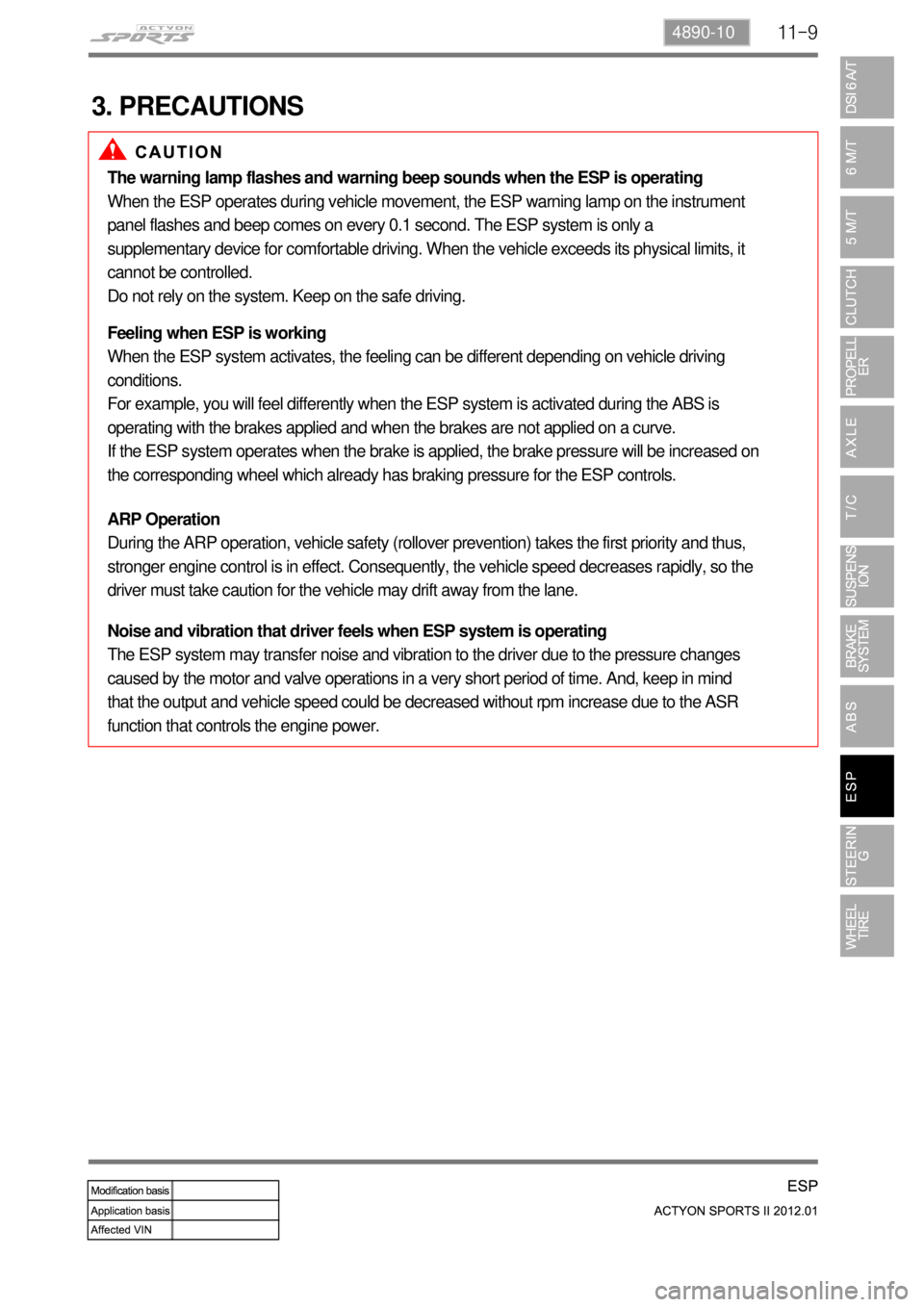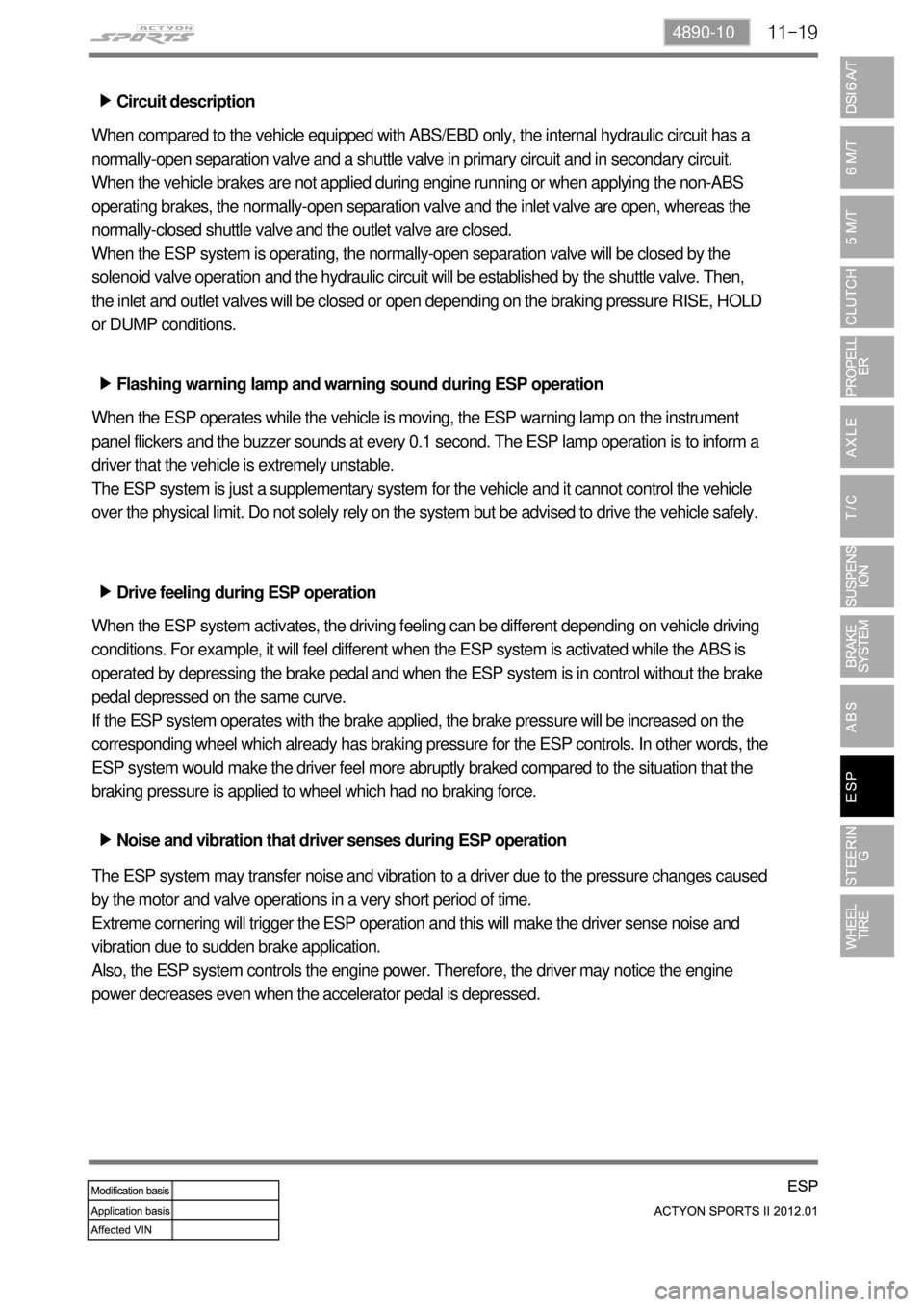Page 664 of 828
09-16
Let the engine run for 1 to 2 minutes and
stop it. If the brake pedal stroke is
shortened as pumping the brake pedal,
the system is normal. If not, the system is
defective.
Depress the brake pedal several times
with engine off. If the brake goes down
when starting engine with pedal
depressed, the system is normal. If not,
the system is defective.
Depress the brake pedal when the engine
is running. If the pedal height is not
changed for 30 seconds after stopping
the engine, the system is normal. If not,
the system is defective. 1.
2.
3.
If the above three checks are OK, the system
is normal. If any condition is not met, check
the valve, vacuum hose and brake booster. Brake Booster ▶
Page 710 of 828

11-94890-10
3. PRECAUTIONS
The warning lamp flashes and warning beep sounds when the ESP is operating
When the ESP operates during vehicle movement, the ESP warning lamp on the instrument
panel flashes and beep comes on every 0.1 second. The ESP system is only a
supplementary device for comfortable driving. When the vehicle exceeds its physical limits, it
cannot be controlled.
Do not rely on the system. Keep on the safe driving.
Feeling when ESP is working
When the ESP system activates, the feeling can be different depending on vehicle driving
conditions.
For example, you will feel differently when the ESP system is activated during the ABS is
operating with the brakes applied and when the brakes are not applied on a curve.
If the ESP system operates when the brake is applied, the brake pressure will be increased on
the corresponding wheel which already has braking pressure for the ESP controls.
ARP Operation
During the ARP operation, vehicle safety (rollover prevention) takes the first priority and thus,
stronger engine control is in effect. Consequently, the vehicle speed decreases rapidly, so the
driver must take caution for the vehicle may drift away from the lane.
Noise and vibration that driver feels when ESP system is operating
The ESP system may transfer noise and vibration to the driver due to the pressure changes
caused by the motor and valve operations in a very short period of time. And, keep in mind
that the output and vehicle speed could be decreased without rpm increase due to the ASR
function that controls the engine power.
Page 720 of 828

11-194890-10
Circuit description ▶
When compared to the vehicle equipped with ABS/EBD only, the internal hydraulic circuit has a
normally-open separation valve and a shuttle valve in primary circuit and in secondary circuit.
When the vehicle brakes are not applied during engine running or when applying the non-ABS
operating brakes, the normally-open separation valve and the inlet valve are open, whereas the
normally-closed shuttle valve and the outlet valve are closed.
When the ESP system is operating, the normally-open separation valve will be closed by the
solenoid valve operation and the hydraulic circuit will be established by the shuttle valve. Then,
the inlet and outlet valves will be closed or open depending on the braking pressure RISE, HOLD
or DUMP conditions.
Flashing warning lamp and warning sound during ESP operation ▶
When the ESP operates while the vehicle is moving, the ESP warning lamp on the instrument
panel flickers and the buzzer sounds at every 0.1 second. The ESP lamp operation is to inform a
driver that the vehicle is extremely unstable.
The ESP system is just a supplementary system for the vehicle and it cannot control the vehicle
over the physical limit. Do not solely rely on the system but be advised to drive the vehicle safely.
Drive feeling during ESP operation ▶
When the ESP system activates, the driving feeling can be different depending on vehicle driving
conditions. For example, it will feel different when the ESP system is activated while the ABS is
operated by depressing the brake pedal and when the ESP system is in control without the brake
pedal depressed on the same curve.
If the ESP system operates with the brake applied, the brake pressure will be increased on the
corresponding wheel which already has braking pressure for the ESP controls. In other words, the
ESP system would make the driver feel more abruptly braked compared to the situation that the
braking pressure is applied to wheel which had no braking force.
Noise and vibration that driver senses during ESP operation ▶
The ESP system may transfer noise and vibration to a driver due to the pressure changes caused
by the motor and valve operations in a very short period of time.
Extreme cornering will trigger the ESP operation and this will make the driver sense noise and
vibration due to sudden brake application.
Also, the ESP system controls the engine power. Therefore, the driver may notice the engine
power decreases even when the accelerator pedal is depressed.
Page 737 of 828

12-114610-01
Oil Change ▶
Open the power fluid reservoir cap and
drain the fluid completely with oil suction
device. To make it easy, turn the steering
wheel to its both ends several times.
Fill up the specified fluid into fluid reservoir
and bleed air from the steering system. 1.
2. Oil Level Check ▶
Place the vehicle on a level ground and
start the engine and let it run at idle speed.
Turn the steering wheel several times so
that the oil temperature reaches to normal
operating level (75~85˚C).
Place the steering wheel at straight ahead
direction.
Check the oil level in the power steering oil
reservoir. Adjust the oil level between MAX
and MIN. 1.
2.
3.
4.
If the difference between two
measurements is below 5 mm and the level
is between MAX and MIN level, it's normal.
If it is over 5 mm, bleed air from the
system. Check the fluid level on a level ground with
the engine turned off. The fluid level should
be between the MIN and MAX marks on the
reservoir cap gauge.
below 5 mm
Engine idling Engine running
Oil typeATF Dexron II or III
Capacityapprox. 1ℓ (including
reservoir)
Page 752 of 828

13-114170-09
1. OVERVIEW
A radial tire uses a cord angle of 90 degrees. That is, the cord material runs in a radial or direct
line from one bead to the other across the tread. In addition, a radial tire has a belt overwrap
under the tread surface to provide greater structural stability. The belt overwrap of a radial tire
distortion while the radial structure enables high speed driving.
Tire supports the weight of the vehicle, reduces the impact from the road and at the same time,
transmits the power to propel, brake and steer on the road. It also functions to maintain a
<009d008c008f0090008a0093008c02c5009a004700940096009d008c0094008c0095009b0055004700700095004700960099008b008c00990047009b00960047008a0096009400970093008c009b008c0047009a009c008a008f0047009b0088009a009200
9a0053004700880047009b00900099008c00470094009c009a>t be structured to be a resilient
vessel of air.
There is wear limit mark on the tire, which protrudes as a strip shape located approximately 1.6
mm from the groove bottom. This wear limit mark is not seen from the outside so there is
additional "▲" mark on the shoulder to let the driver find the wear mark easily. To measure the tire
groove depth, measure at any point other than the point which has a wear limit mark.
The tire is worn unevenly according to the driver's driving habit, improper servicing, low tire
inflation pressure, changed tire location, etc.
Page 768 of 828
01-116810-01
(5) Step 5
In this step, the system checks the temperature sensors used to control the A/C. To enter this
step, turn the temperature dial to the right in the step 4. The ambient temperature appears on the
display first and the interior temperature appears next and the intake air temperature last. The
display changes the temperature value each time the defroster switch is pressed.
1. Turn temperature dial lightly toward right to enter step 5
Press Press Press
Ambient
temperature
displayInterior
temperature
displayIntake air
temperature
display
(6) Step 6
You can increase or decrease by up to 3 degrees from the set temperature. When entering the
step 6 from 5, turn the fan speed dial.
Step 6 starts Decrease by up
to 3 degreesIncrease by up
to 3 degreesTurn fan
speed dial
to enter
step 6 1.
Turn
temperature
control dial to
adjust
temperature 2.
Page:
< prev 1-8 9-16 17-24